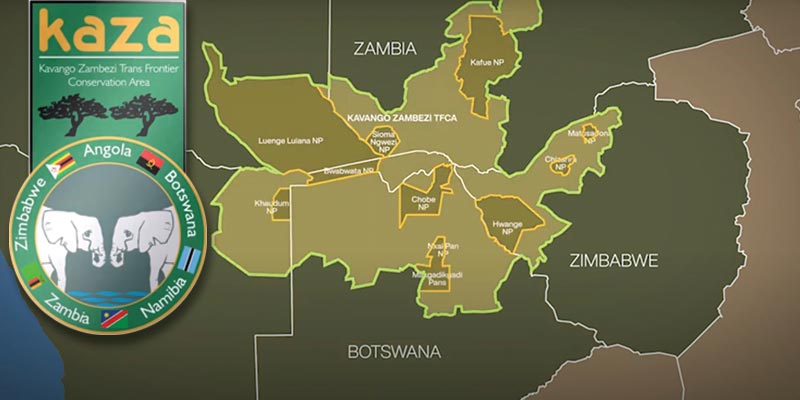- World
- Jun 01
Explainer - Kavango-Zambezi (KAZA) Transfrontier Conservation Area
• Five Southern African countries have committed to expanding the use of a special common visa to allow easier movement of tourists as the region seeks to boost arrivals.
• Officials from Angola, Botswana, Namibia, Zambia and Zimbabwe, countries that make up the Kavango-Zambezi (KAZA) Transfrontier Conservation Area, pledged in principle to broaden use of the special visa, called a “univisa”, which allows entry into multiple countries.
• The univisa is currently used in Zambia and Zimbabwe and covers day trips to Botswana through Kazungula.
• KAZA member states also resolved to urge the Convention on International Trade in Endangered Species of Wild Fauna and Flora (CITES) to lift a ban on the trade of elephants and ivory.
• Zambia hosted the KAZA Summit on May 31 in the city of Livingstone.
What are Transfrontier Conservation Areas?
• Transfrontier Conservation Areas (TFCAs) are areas of land and/or sea that straddle international (or sub-national) borders, that are jointly or cooperatively managed for conservation and/or sustainable natural resource utilisation.
• The concept recognises that borders are political rather than ecological, and aims to ensure that key ecological processes continue to function where borders have divided ecosystems, river basins and/or wildlife migration routes.
• The ecological rationale associated with Transfrontier Conservation Areas is very similar to that of simply increasing land area under sustainable management, but TFCAs attempt to improve the cooperative management of shared resources, increase the area available for wildlife and plant populations (reducing their vulnerability to shocks) and re-establish migratory routes that may have been disrupted by a lack of coordinated management between countries.
• TFCAs are also said to improve the livelihoods of communities whose traditional lands have been divided by international boundaries, particularly through the facilitation of the resumption and/or legalisation of cross border movements (in order, partly, to support cultural ties and traditions).
• Finally, cross-border cooperation is thought to increase the efficiency of monitoring and managing natural resources, reduce and/or eliminate duplication of efforts, and create economies of scale, as well as enhance economic opportunities.
Kavango-Zambezi Transfrontier Conservation Area
• Kavango-Zambezi Transfrontier Conservation Area (KAZA TFCA) is enormous, larger than Germany and Austria combined and nearly twice as large as the United Kingdom.
• It lies in the Kavango and Zambezi river basins where Angola, Botswana, Namibia, Zambia and Zimbabwe converge.
• The KAZA TFCA was established following the signing of the KAZA Treaty on August 18, 2011.
• KAZA is the largest land based TFCA in the world, approximately 520,000 sqkm, located in parts of the Okavango and Zambezi river basin regions of Angola, Botswana, Namibia, Zambia, and Zimbabwe.
• KAZA is a partnership centred around a common vision to conserve biodiversity at scale, through promoting integrated transboundary management and to market the landscape’s biodiversity using nature-based tourism as the engine for rural economic growth and development.
• The KAZA vision is underpinned by several objectives outlined in full in the KAZA Treaty.
• Jewels in the crown of this spectacular array of protected areas are the 15,000 sqkm Okavango Delta, an explosion of green and blue in parched landscape — the world’s largest inland delta, and the awe inspiring tumbling cataracts of the Victoria Falls, a World Heritage Site and one of the seven natural wonders of the world.
• The sheer scope of this park provides both range and opportunity for species diversity.
• There are four key structural vegetation types within the park including grassland, wetland, dry forest and a variety of woodland types covering the greatest portion of the area, as well as saltpans and scrublands.
• There are more than 3,000 plant species throughout the park, of which 100 are endemic to the sub-region.
• The park is also home to the largest contiguous population of African elephants (approximately 250,000).
• The area caters to large-scale migrations of mega fauna, including several Red Data List species, of global biological importance; the park contributes to the conservation of threatened species such as African wild dog, wattled crane, Nile crocodile and cheetah.
Objectives of KAZA Treaty:
• Maintain and manage the shared natural and cultural heritage resources.
• Promote and facilitate the development of a complementary and linked network of protected areas.
• Provide opportunities and facilities and infrastructure for tourism development (including facilitating transboundary development and free movement of tourists across borders).
• Protect wildlife and provide and restore dispersal corridors and migratory routes.
• Develop and implement programmes to enhance the sustainable use of natural resources and cultural resources for livelihoods improvement and poverty reduction.
• Promote and facilitate the harmonisation of relevant legislation, policies, and approaches in natural and heritage resources management (and transboundary animal diseases prevention, surveillance, and control).
Manorama Yearbook app is now available on Google Play Store and iOS App Store



